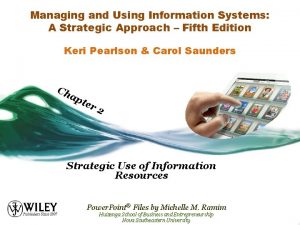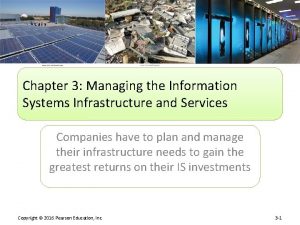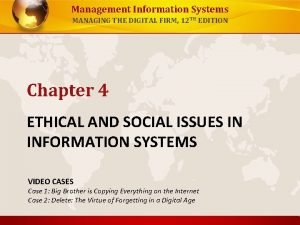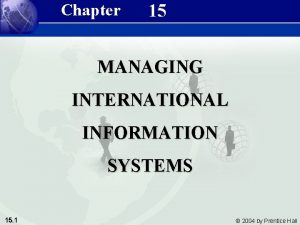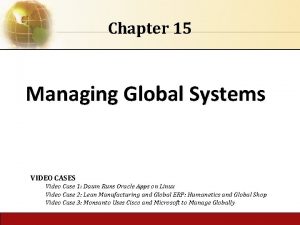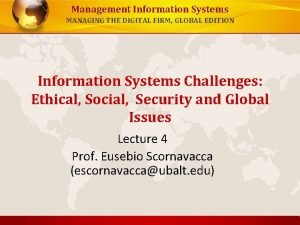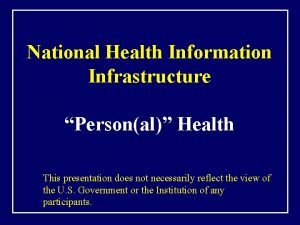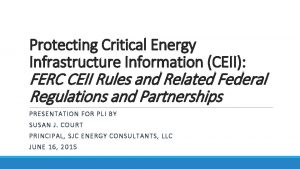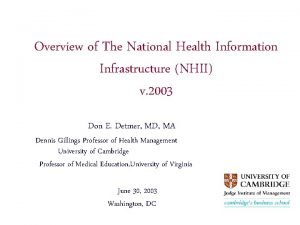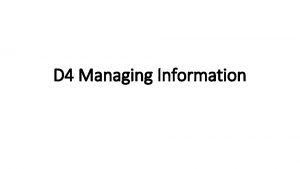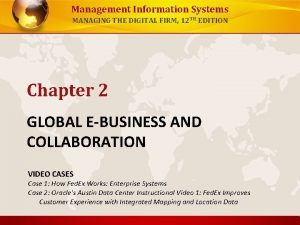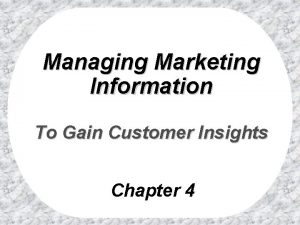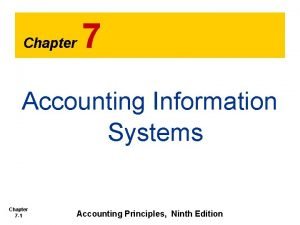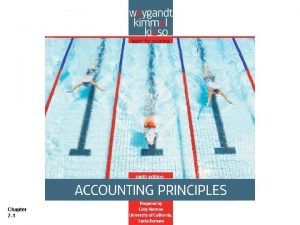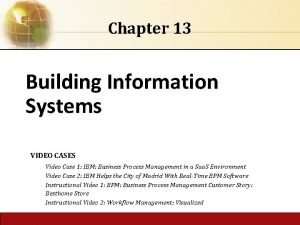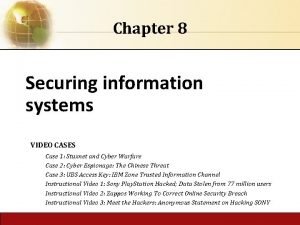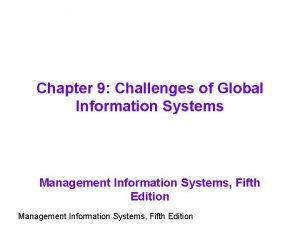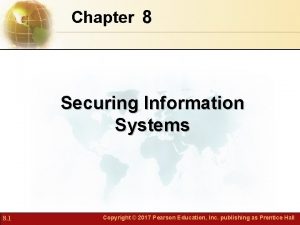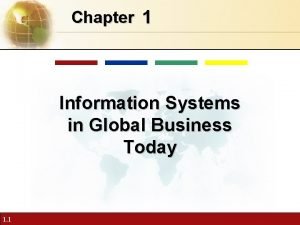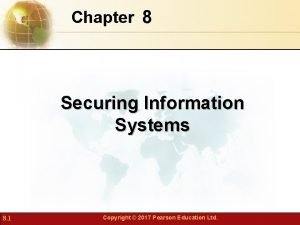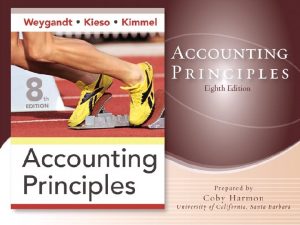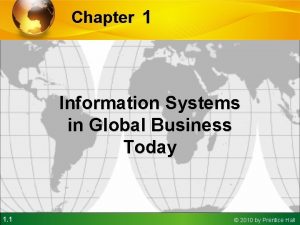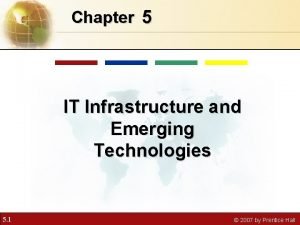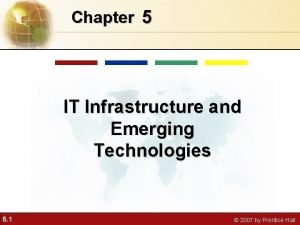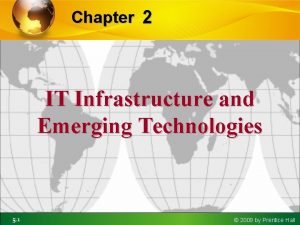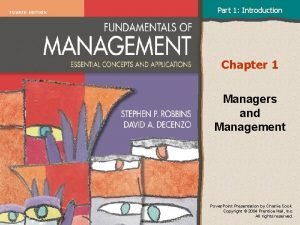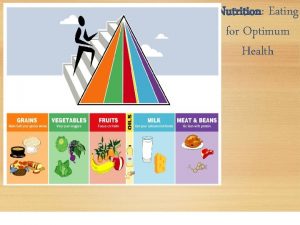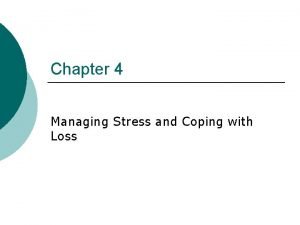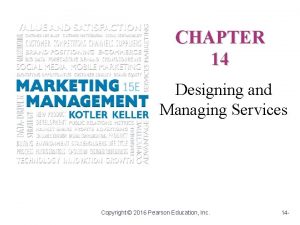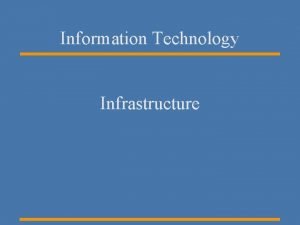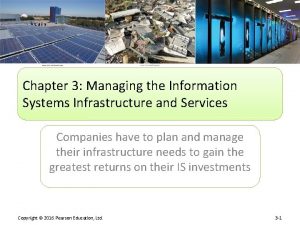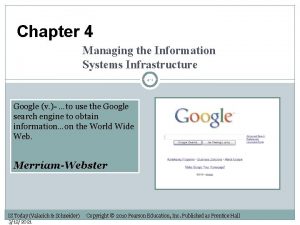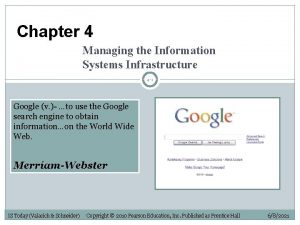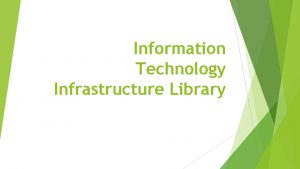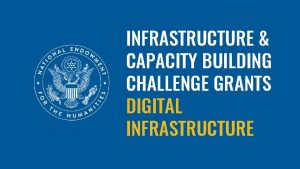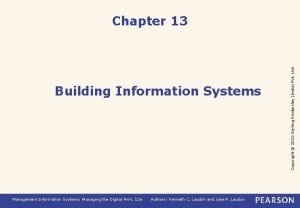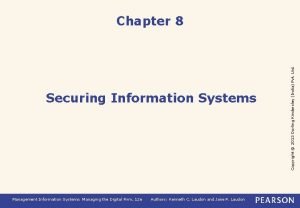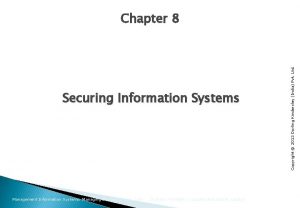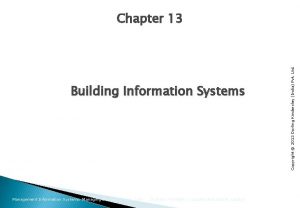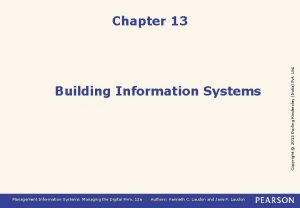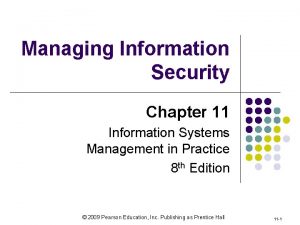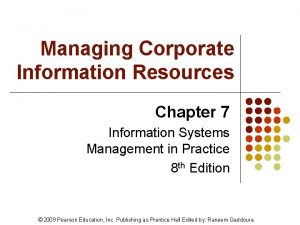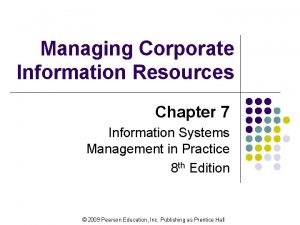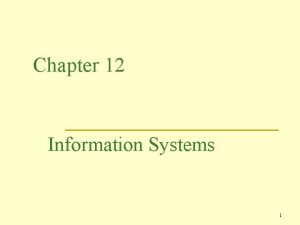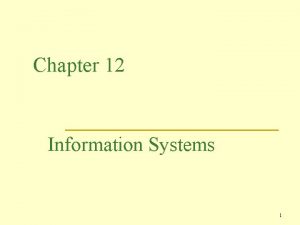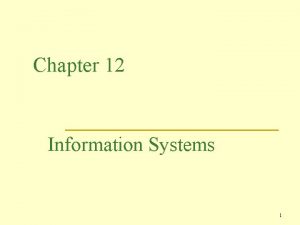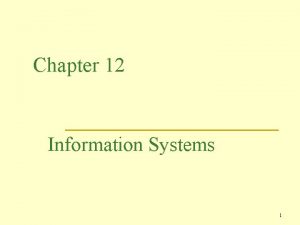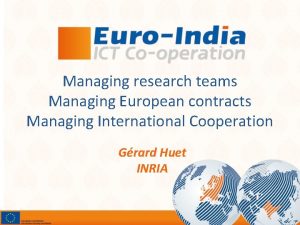Chapter 3 Managing the Information Systems Infrastructure and

















































- Slides: 49

Chapter 3: Managing the Information Systems Infrastructure and Services Companies have to plan and manage their infrastructure needs to gain the greatest returns on their IS investments Copyright © 2016 Pearson Education, Inc. 3 -1

Chapter 3 Learning Objectives The IS Infrastructure • Describe how changes in businesses’ competitive landscape influence changing IS infrastructure needs • Describe the essential components of an organization’s IS infrastructure. Issues Associated with Managing the IS Infrastructure • Discuss managerial issues associated with managing an organization’s IS infrastructure. Cloud Computing • Describe cloud computing and other current trends that can help an organization address IS infrastructure–related challenges. Copyright © 2016 Pearson Education, Inc. 3 -2

The IS Infrastructure • Describe how changes in businesses’ competitive landscape influence changing IS infrastructure needs. • Describe the essential components of an organization’s IS infrastructure. Issues Associated with Managing the IS Infrastructure Discuss managerial issues associated with managing an organization’s IS infrastructure. Cloud Computing Describe cloud computing and other current trends that can help an organization address IS infrastructure–related challenges. Copyright © 2016 Pearson Education, Inc. 3 -3

The Is Infrastructure • Businesses rely on an information systems infrastructure – – – Hardware System software Storage Networking Data centers Copyright © 2016 Pearson Education, Inc. 3 -4

Applications and Databases Supporting Business Processes • Application Software – Software tools • • Process automation Decision support Financial monument Other business and user needs • Databases – Collections of data – Organized to facilitate data searches Copyright © 2016 Pearson Education, Inc. 3 -5

IS Infrastructure Components: Hardware—Computer Types (Table 3. 1) Copyright © 2016 Pearson Education, Inc. 3 -6

IS Infrastructure Components: System Software • Controls computer hardware operations • Operating systems – Examples: Windows, OS X, Ubuntu, Linux – Manages hard drives and storage – Manages keyboard, mouse, monitor, and printers – Coordinates application access to computing resources Copyright © 2016 Pearson Education, Inc. 3 -7

IS Infrastructure Components: Storage Type Purpose Operational For processing transactions or for data analysis Backup Short-term copies of organizational data, used to recover from system-related disaster. Backup data are frequently overwritten with newer backups Archival Long-term copies of organizational data, often used for compliance and reporting purposes Copyright © 2016 Pearson Education, Inc. 3 -8

IS Infrastructure Components: Networking Both human and computer communication involve senders, a message to share, and receivers. Network requires: • Sender and receiver • Transmission pathway • Rules/protocols for communication Copyright © 2016 Pearson Education, Inc. 3 -9

IS Infrastructure Components: Servers, Clients, and Peers • Servers – Host (serve up) data, databases, files, applications, Web sites, video, and other content for access over the network • Clients – Consume hosted resources • Peers (P 2 P) – Serve and consume resources, both a server and a client interacting with similar computers Copyright © 2016 Pearson Education, Inc. 3 -10

IS Infrastructure Components: Types of Computer Networks Type Personal area network (PAN) Local area network (LAN) Wide area network (WAN) Usage Size Wireless communication Under 10 meters between devices (Bluetooth) Sharing of data, software applications, and other resources between several users Connect multiple LANs, distributed ownership and management Copyright © 2016 Pearson Education, Inc. Typically a building Large physical distance, up to worldwide 3 -11

The Internet and the World Wide Web (WWW) • The Internet is one of several global networks – The Internet has standard protocols – The Internet is based on internetworking, or combining networks to form larger networks • The World Wide Web uses the Internet – The World Wide Web is not the Internet – The World Wide Web is • Web protocols (e. g. , HTML and HTTP) • Web pages (documents containing HTML ) • Web servers (store and provide access to Web pages via a Web site) • Web browsers (provide users with an interface to Web pages) Copyright © 2016 Pearson Education, Inc. 3 -12

The Internet and the World Wide Web: Web Domain Names and Addresses • Uniform Resource Locator (URL) is used to identify and locate a particular Web page • Domain name is a term that helps people recognize the company or person – Prefix, like “google” or “microsoft” – Suffix, like. com, . edu, . org, . gov, or two-letter country codes Copyright © 2016 Pearson Education, Inc. Dissecting a URL. 3 -13

The Internet and the World Wide Web: IP Addresses • The Internet uses IP addresses – IPV 4: Old style, 32 -bit, running out of addresses – IPV 6: New style, 128 -bit, huge address space • The WWW translates domain names into IP addresses – www. arizona. edu translates to (IPV 4) 128. 196. 134. 37 • A URL could be expressed directly as an IP address, although it’s more common to use domain name. Copyright © 2016 Pearson Education, Inc. 3 -14

The Internet and the World Wide Web: World Wide Web Architecture • Components – Interconnected Web servers – Utilize Transmission Control Protocol/Internet Protocol (TCP/IP) – Communicate over the Internet • • • Clients request Web page hosted on server Server breaks into packets Packets stream over internet to client Client reassembles Client can request retransmission of any missing packets Web browser translates Web page into visible output Copyright © 2016 Pearson Education, Inc. 3 -15

The Internet and the World Wide Web: Extranets and Intranets • Companies have confidential data • These data still need to be shared on a limited basis – Intranet: password-protected Web site designed for sharing within the company – Extranet: password-protected Web site designed for sharing with select partners • Data and communication are protected via firewalls and virtual private networks (VPNs) Copyright © 2016 Pearson Education, Inc. 3 -16

The Internet and the World Wide Web: Extranets and Intranets Intranet architecture Extranet architecture Copyright © 2016 Pearson Education, Inc. 3 -17

IS Infrastructure Components: Data Centers • Large amounts of data to be managed • Dedicated space for infrastructure components such as data centers • Data center centralization facilitates – Management – Repairs – Upgrades – Security Copyright © 2016 Pearson Education, Inc. 3 -18

Issues Associated with Managing the IS Infrastructure The IS Infrastructure Describe how changes in businesses’ competitive landscape influence changing IS infrastructure needs. Describe the essential components of an organization’s IS infrastructure. Issues Associated with Managing the IS Infrastructure Discuss managerial issues associated with managing an organization’s IS infrastructure. Cloud Computing Describe cloud computing and other current trends that can help an organization address IS infrastructure–related challenges. Copyright © 2016 Pearson Education, Inc. 3 -19

Rapid Obsolescence and Shorter IT Cycles Copyright © 2016 Pearson Education, Inc. 3 -20

The Dawn of Computing • 1936 – Zeus Z 1 computer introduced • Mechanical computer • Punch-card based – Business and government information systems • Paper based • Huge rooms full of filing cabinets • Specific information known by few employees Copyright © 2016 Pearson Education, Inc. 3 -21

Six Generations of Computing Genera tion Time Line Major Event Characteristics 1 1946– 1958 Vacuum tubes ■ Mainframe era begins ■ ENIAC and UNIVAC were developed 2 1958– 1964 Transistors ■ Mainframe era expands ■ UNIVAC is updated with transistors 3 1964– 1990 s Integrated circuits ■ Mainframe era ends, PC begins ■ Microprocessor revolution 4 1990 s– 2000 Multimedia and low ■ PC era ends, interpersonal begins -cost PCs ■ High speed and capacity ■ Low-cost integrated AV and data 5 2000– 2010 Internet accessibility ■ Internetworking era begins ■ Ubiquitous Internet access 6 2010 -present Ubiquitous mobile connectivity ■ Advent of mobile connectivity ■ Big Data, cloud computing ■ Internet of Things ■ Social networking Copyright © 2016 Pearson Education, Inc. 3 -22

Moore’s Law • Dr. Gordon Moore – Co-founder of Intel – Hypothesized that the number of transistors on a chip would double every two years – Transistors predicted computing power • • Computing power would double every two years Has been relatively accurate to this date First CPU had 2200 transistors Current CPUs have over 5 billion Copyright © 2016 Pearson Education, Inc. 3 -23

IT Cycles and Obsolescence • Powerful computers enable new applications • New applications drive efficiencies • New applications often make old hardware obsolete • Obsolete hardware requires replacement Copyright © 2016 Pearson Education, Inc. 3 -24

Big Data and Rapidly Increasing Storage Needs • Firms collect unprecedented levels of data – Business intelligence (Chapter 6) – Legal compliance (e. g. , Sarbanes-Oxley) • Unprecedented levels of data require unprecedented infrastructure capabilities – More storage space, powerful hardware, and database management – Ever-increasing Internet bandwidth – Vicious cycle: enhanced capacity drives new applications, requiring even more capacity Copyright © 2016 Pearson Education, Inc. 3 -25

Demand Fluctuations • Many companies face demand fluctuations – Seasonal fluctuations (e. g. , December holidays) – Monthly fluctuations (month-end spikes) • Demand fluctuations create inefficiencies – Some estimate up to 70% of IS capacity only used 20% of the time – IS infrastructure is typically not readily scalable • Changing internal capacity takes time • Cloud computing (next section) may be the answer Copyright © 2016 Pearson Education, Inc. 3 -26

Increasing Energy Needs • Computing can require a lot of power – Hardware draws power, which generates heat – Heat requires cooling, which requires more power • Data centers can use large amounts of power – 15 to 17 kilowatts per rack – Large data centers have hundreds of racks – More power is required for cooling and lost through other inefficiencies Copyright © 2016 Pearson Education, Inc. 3 -27

Cloud Computing The IS Infrastructure Describe how changes in businesses’ competitive landscape influence changing IS infrastructure needs. Describe the essential components of an organization’s IS infrastructure. Issues Associated with Managing the IS Infrastructure Discuss managerial issues associated with managing an organization’s IS infrastructure. Cloud Computing Describe cloud computing and other current trends that can help an organization address IS infrastructure–related challenges. Copyright © 2016 Pearson Education, Inc. 3 -28

What Is Cloud Computing? • Cloud Computing is a way to allocate resources much like a utility sells power – Resources are used “on-demand, ” as needed – Customers only pay for what they consume – Resources can be rapidly allocated and reallocated – Consumption becomes an operating expense – % utilization and efficiency increase dramatically Copyright © 2016 Pearson Education, Inc. 3 -29

Why Cloud Computing? • The efficiency benefits are tremendous – Different customers have different demand spikes – Large data centers have economies of scale • Purchasing, deploying, and managing technology • Implementing green cooling technologies • Flexibly reallocating resources • Customers can focus on core operations – Infrastructure can be consumed as needed – Scalability no longer a limiting factor Copyright © 2016 Pearson Education, Inc. 3 -30

Cloud Computing Characteristics • On-Demand Self-Service • Rapid Elasticity • Broad Network Access Copyright © 2016 Pearson Education, Inc. • Resource Pooling • Measured Service 3 -31

Cloud Computing Service Models • Infrastructure as a Service (Iaa. S) • Platform as a Service (Paa. S) • Software as a Service (Saa. S) Copyright © 2016 Pearson Education, Inc. 3 -32

Public and Private Clouds Copyright © 2016 Pearson Education, Inc. 3 -33

Managing the Cloud • • Availability/Reliability Scalability Viability Security, Privacy, and Compliance Diversity of Offerings Openness Costs Copyright © 2016 Pearson Education, Inc. 3 -34

Advanced Cloud Applications: Service-Oriented Architecture (SOA) • Services—individual components of business processes – building blocks • Principles of SOA – Reusability – Interoperability – Componentization Copyright © 2016 Pearson Education, Inc. Using SOA, multiple applications can invoke multiple services 3 -35

Advanced Cloud Applications: Grid Computing • Extremely complex problems need heavy computing power • Traditionally handled by supercomputers, but – Supercomputers are very expensive – Even supercomputers may not be able to handle the demand • Grid computing—combine many small, networked computers – Decompose and distribute large complex problems Copyright © 2016 Pearson Education, Inc. 3 -36

Advanced Cloud Applications: Content Delivery Networks Content delivery networks store copies of content closer to the end user Copyright © 2016 Pearson Education, Inc. 3 -37

Advanced Cloud Computing: Convergence of Computing and Telecommunications • Voice and data traffic sharing a common network infrastructure – Voice over IP (Voi. P): IP telephony – Video conferencing over IP Copyright © 2016 Pearson Education, Inc. 3 -38

Green Computing • Driving forces – Power bills – Reputation – Culture • Approaches – Virtualizing servers – Cloud computing – Power management software – Reduced printing – Retiring obsolete hardware responsibly Copyright © 2016 Pearson Education, Inc. 3 -39

END OF CHAPTER CONTENT Copyright © 2016 Pearson Education, Inc. 3 -40

Managing in the Digital World: “I Googled You!” • “Google” is now a verb • While known for search, Google actually has a wealth of products – Google docs: cloud-based productivity software – Other products include You. Tube, Gmail, Google maps, Chrome, and Android – Ad. Sense, Google Scholar, Finance, Translate, Images • Continuously evolving and innovating Copyright © 2016 Pearson Education, Inc. 3 -41

Who’s Going Mobile: Mobile Developments in Developing Countries • Developing countries have poor infrastructure for communications technologies such as telephone lines • Cellular technologies are much less expensive, so more accessible to poorer nations • Cell phones and smartphones have revolutionized entire economies • Kenya has the world’s largest mobile payment platform (M-Pesa) • Smartphones still relatively rare, but use is growing Copyright © 2016 Pearson Education, Inc. 3 -42

Ethical Dilemma: Putting People’s Lives Online • Google Street View captures millions of people in their everyday lives – Put online for the world to see – Not all pictures are of things people want online • People in places or with people they don’t want public – Can be very intrusive, can even ruin lives – If pictures can be monetized, do companies have a shareholder duty to do so, regardless of consequences to some individuals? Copyright © 2016 Pearson Education, Inc. 3 -43

Coming Attractions: Internet for Everyone • Developing nations and rural areas have less access to Internet infrastructure • Significant disadvantage in global economy • Large companies (e. g. Google, Facebook) want to access these people • Experimental projects: – Google Project Loon: balloons equipped with solar -powered wireless transmitters – Facebook using drones to transmit Wi-Fi signals Copyright © 2016 Pearson Education, Inc. 3 -44

Brief Case: For Sale by Owner—Your Company’s Name. com • Business, organizations, and celebrities want their own domain names • Domainers: people that deal in Internet “real estate” • How domainers rent ad space – Buy a domain name (e. g. , cellphones. com) and hold onto it – Direct traffic to an “aggregator” (middleman) – When searcher clicks, search engine owner or advertiser pays domainer a fee • Attempts to curb this practice: – Anti-Phishing Consumer Protection Act (2008)—stalled – Coalition Against Domain Name Abuse (CADNA) Copyright © 2016 Pearson Education, Inc. 3 -45

When Things Go Wrong: Dirty Data Centers • 2011 Greenpeace report on data centers and the cleanliness of their energy sources – Apple dirtiest of all, closely followed by HP, IBM, and Oracle – Google came in 5 th – Companies now trying to both become more efficient, get power from non-polluting sources • Use air for cooling, recapture heat for heating • Power from solar, wind, and other non-polluting sources Copyright © 2016 Pearson Education, Inc. 3 -46

Key Players: Giants of the Infrastructure • Dell: 41 st on the fortune 500, third-largest PC maker in the world • IBM: Multinational company and consulting firm, most patents of any U. S. technology company • HP: Known mostly for printers, but also large producer of personal computing products, servers, and networking equipment • Cisco: Networking company, branching out in collaboration, security, and data center services • Rackspace: Cloud hosting company, public and private hosting on a global basis Copyright © 2016 Pearson Education, Inc. 3 -47

Industry Analysis: Movie Industry • Computers allow studio-quality digital editing at an affordable price – Independent filmmakers can compete • CGI for digital effects (Dreamworks, Universal, Weta Digital, Pixar) • Movies released in digital formats • Movie theaters switching to digital projection systems • Theaters receive movies electronically instead of on reels Copyright © 2016 Pearson Education, Inc. 3 -48

Copyright © 2016 Pearson Education, Inc. 3 -49
 Managing and using information systems
Managing and using information systems Information system infrastructure
Information system infrastructure Management information systems managing the digital firm
Management information systems managing the digital firm Managing global systems chapter 15
Managing global systems chapter 15 Chapter 4 ethical issues
Chapter 4 ethical issues 4 components of an information system
4 components of an information system Chapter 3 information systems organizations and strategy
Chapter 3 information systems organizations and strategy Global systems 1 management
Global systems 1 management Managing global systems
Managing global systems Information infrastructure
Information infrastructure Ceii ferc
Ceii ferc Itil information technology infrastructure library
Itil information technology infrastructure library National health information infrastructure
National health information infrastructure Despite the data glut that marketing managers
Despite the data glut that marketing managers Procedures relating to the management of information
Procedures relating to the management of information Information technology resource
Information technology resource Management information system managing the digital firm
Management information system managing the digital firm Importance of rest
Importance of rest Managing marketing information
Managing marketing information Functions of an information system
Functions of an information system Chapter 8 securing information systems
Chapter 8 securing information systems Chapter 8 securing information systems
Chapter 8 securing information systems Chapter 7 accounting information systems
Chapter 7 accounting information systems Chapter 7 accounting information systems
Chapter 7 accounting information systems Chapter 13 building information systems
Chapter 13 building information systems Chapter 8 securing information systems
Chapter 8 securing information systems Fundamentals of information systems chapter 1
Fundamentals of information systems chapter 1 Fundamental of information system
Fundamental of information system Challenges of global information system
Challenges of global information system Chapter 8 securing information systems
Chapter 8 securing information systems Information systems in global business today
Information systems in global business today Introduction management information system
Introduction management information system Chapter 8 securing information systems
Chapter 8 securing information systems Chapter 7 accounting information systems
Chapter 7 accounting information systems Information system in global business
Information system in global business Chapter 5 it infrastructure and emerging technologies
Chapter 5 it infrastructure and emerging technologies Chapter 5 it infrastructure and emerging technologies
Chapter 5 it infrastructure and emerging technologies Chapter 5 it infrastructure and emerging technologies
Chapter 5 it infrastructure and emerging technologies Chapter 8 managing stress and anxiety
Chapter 8 managing stress and anxiety Leasiest
Leasiest Chapter 6 managing weight and body composition
Chapter 6 managing weight and body composition Extreme harmful eating behaviors
Extreme harmful eating behaviors An extreme harmful eating behavior
An extreme harmful eating behavior Management chapter 1
Management chapter 1 Managing weight and eating behaviors
Managing weight and eating behaviors Chapter 6 managing weight and body composition
Chapter 6 managing weight and body composition 7 types of jaycustomers
7 types of jaycustomers Chapter 11 managing weight and eating behaviors answer key
Chapter 11 managing weight and eating behaviors answer key Chapter 4 managing stress and coping with loss
Chapter 4 managing stress and coping with loss Services are typically produced and consumed simultaneously
Services are typically produced and consumed simultaneously
